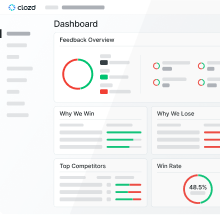
It’s time to adapt—right now
As the world grapples with the effects and uncertainty of an economic downturn, businesses are feeling the pressure.
Some industries have already taken a direct hit and laid off significant numbers of employees. Most B2B solution providers (i.e., software, professional services, etc.) are slowing down their activity and decision-making as they try to gauge the situation.
We’re not sure how long the downturn will last, but several things are clear:
- The world is different now than it was just a month ago.
- Markets are changing.
- Buyer behavior is evolving.
Your business needs to adapt right now if you want to survive (or thrive) through the recession.
Specific themes and trends are starting to emerge across the hundreds of B2B win-loss interviews conducted each month by Clozd consultants.
In spite of the challenges, wise business leaders will sense this challenging economic time as an opportunity.
Economic downturns present an opportunity
Macroeconomic downturns filter the weak and unstable competitors out of each market.
There are many studies—from reputable management consulting firms—that analyze what happens.
The Boston Consulting Group conducted a study that showed how 30% of companies that were among the top 10 in their respective sectors dropped off that list during a recession.
Fewer than 10% of those that dropped off ever made it back.
Their conclusion is that a downturn magnifies the relative strengths and weaknesses of each company.
A study by McKinsey concluded that when companies manage to double down on their investments in research/development and sales/marketing during a downturn, they emerge with higher valuations and surging momentum in the upswing.
“Companies don’t want growth for growth’s sake. They want value creation. We define growth outperformers as companies that grow faster and have higher profits than their peers. Those that outperform throughout an economic cycle generate three times the revenues during the downturn as others and have nine times higher profitability.
“Their growth starts during the downturn, and that turbocharges their ability to outperform in the recovery.”
—Rebecca Doherty | McKinsey, Growth through a downturn
Every company is under pressure right now. There’s no way to avoid the risk, so don’t bother trying.
As a revenue leader, you should adjust your expectations and start taking actions that will help you gain ground relative to your competitors during the downturn. You can position your company to thrive by implementing the tips below.
1. Stay lean
If you’re not accustomed to operating lean financially, then it may be too late. Companies that weren’t in sound financial shape at the beginning of the downturn are already cutting costs, laying off staff, and figuratively crossing their fingers. If you were already financially disciplined, stay that way.
“Managing burn throughout the life cycle of a company prepares startups to weather tough conditions over a sustained period. The typical Silicon Valley startup has a cash trajectory with a deep ‘valley of death.’”
—Alex Lazarow | HBR, Startups, it’s Time to Start Thinking Like Camels – Not Unicorns
2. Double down on your go-to-market effort
Notice that the focus is on effort, not dollar investment.
Be creative and focused in lead-generation activities. Figuratively, get “all hands on deck” to help drive business. Reset your culture to treat every deal in your sales pipeline as though it’s make or break—because that’s true in a downturn.
What lead-generation activities have been most successful in the past?
What lead sources have the highest ROI?
Which buyers are most likely to close?
How can you get laser-focused on spending your time and resources on deals that have the highest likelihood of closing?
3. Don’t be stagnant—advance your offering
Do you know why you win deals against your biggest competitors?
Understanding why you win can be like discovering a superpower. It will allow you to build on your strengths and find creative ways, given your resource constraints, to advance and differentiate your offering.
Maybe your UX is head-and-shoulders above the competition …
Or you have features or integrations that none of your competitors have …
Or maybe your customer success team is the stuff of legend.
If you can incrementally improve your strengths during a downturn (while most of your competitors stagnate), your growth coming out of the recession will be exponential.
4. Adapt your pricing model and packaging
Make your solution(s) as easy to buy as possible.
Be aggressive in removing roadblocks or pain points in the evaluation and negotiation processes. This may necessitate changes to your product offering and packaging.
“Use pricing to generate incremental revenue from your segmented customer base. Strive for ‘first-class,’ ‘business-class,’ and ‘economy’ pricing, the way the airlines do. First-class customers receive extra value with minimal discounting; economy customers get minimum value. Such segmentation based on price sensitivity creates sales opportunities that can offset losses in other areas, especially since there is often little difference in production costs among the offerings. In addition, a premium offering ... can motivate price-sensitive buyers to move up to midrange offerings in the pursuit of additional value.”
—Nick Wreden | HBR, How to Think About Pricing Strategies in a Downturn - Your Best Downturn Strategy? Think Twice About Price Cuts
Think “starter package” at a discounted price. Gaining market share during a downturn magnifies your gains in the upswing.
5. Stay focused on your customers
It’s more important than ever to deliver real value to your existing customers. They’re the lifeblood that will sustain you during the downturn.
Increase your communication.
Overdeliver on value.
Remember, increasing customer retention by 5% can increase profits from 25–95%.
Get creative and go the extra mile to reward them for sticking with you.
6. Be diligent and patient
During times of economic strife, you’ll likely face more rejection than normal.
Some of your efforts will feel like they’re in vain, as they won’t result in closed-won deals.
These efforts, though, will generate pent-up demand that will be rewarded when the economy turns back around.
Your investment in creating relationships with the right people, building good will, and educating the marketplace on your solution will position you as a leader coming out of the downturn.
Bonus: “Tune in” to why you win and lose
More than ever, you need to understand the nuances of each won and lost opportunity. Leaders need to be continuously “tuned in” to why the business is winning and losing.
One of the reasons we love win-loss analysis as a category is that we help companies refine and improve their operational efficiency. Effective win-loss analysis—especially during a downturn— increases sales productivity, optimizes product development, exposes gaps in pricing models, and drives strategic alignment around how to win more customers.
To learn how to conduct effective win-loss analysis, download our guide.
Avoid missteps, adapt on the fly, and come out ahead
Companies that double down on win-loss analysis during a downturn are able to avoid missteps, adapt on the fly, and come out ahead. Here are some specific examples of how you can leverage win-loss analysis to ensure that you’re on the winning side coming out of the downturn:
- Stakes are higher in a downturn. Leverage your win-loss data to drive strategic alignment and set the right priorities. Resources are limited, and win-loss analysis helps you avoid costly missteps.
- Win-loss analysis helps you monitor how buyer expectations, preferences, and behaviors are evolving throughout the downturn. You can then respond more quickly than your competitors. Adjust your messaging, pricing, and product roadmap on the fly.
- Leverage insights and learnings from wins to motivate and train your sales team. Understanding your successes will help your reps believe that winning is possible, and it will give them a more effective playbook for replicating those victories.
- Leverage insights and learnings from losses to avoid making the same mistakes twice. Treat every deal like it’s make-or-break. Win-loss analysis uncovers why you fell short so that you can adapt.
A small investment in win-loss analysis will enable you to multiply your gains during the downturn and emerge as a leader on the upswing.
If you want to learn more about how a comprehensive win-loss analysis program could help you win in a downturn, let’s talk.

Spencer Dent is one of the founding partners of Clozd, a leading consultancy for B2B win-loss analysis, and a former Case Team Leader at Bain & Company.











.svg)










.svg)

.svg)




